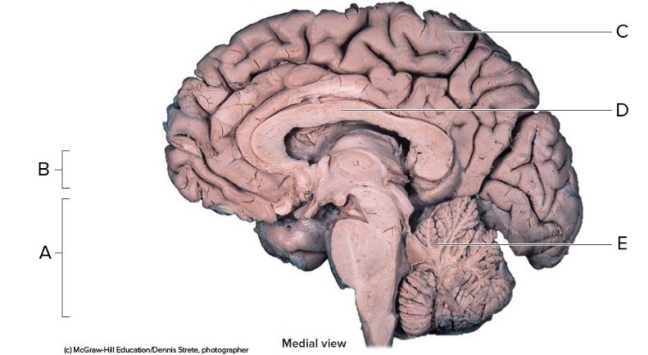A) Flex his fingers
B) Talk to the surgeon
C) Smile
D) Feel pressure on his toes
E) Move his hand
Correct Answer

verified
D
Correct Answer
verified
Multiple Choice
A deer hunter lost the hearing in his right ear after his gun exploded when he tried firing it. His hearing loss is the result of damage to the ________ nerve.
A) vagus
B) hypoglossal
C) glossopharyngeal
D) trigeminal
E) vestibulocochlear
Correct Answer

verified
Correct Answer
verified
Multiple Choice
The nucleus for the facial nerve (cranial nerve VII) is located in the ________.
A) pons
B) medulla
C) mesencephalon
D) cerebrum
E) cerebellum
Correct Answer

verified
Correct Answer
verified
Multiple Choice
Identify the structures that are part of the epithalamus. (Check all the apply.)
A) Habenula
B) Mammillary bodies
C) Pineal gland
D) Pituitary gland
E) Thalamus
Correct Answer

verified
Correct Answer
verified
Multiple Choice
The cerebral medulla
A) has the same function as the medulla oblongata.
B) is the gray matter on the cerebrum's surface.
C) consists of many nerve tracts of white matter beneath the cerebral cortex.
D) is another name for the basal nuclei.
E) is the outer layer of the cerebrum.
Correct Answer

verified
Correct Answer
verified
Multiple Choice
Unilateral damage to a cranial nerve is suspected because the tongue deviates to the right when it is protruded. Which cranial nerve is damaged?
A) Right hypoglossal
B) Left hypoglossal
C) Right glossopharyngeal
D) Left glossopharyngeal
E) Left facial
Correct Answer

verified
Correct Answer
verified
Multiple Choice
Sixteen-year-old Jake is diagnosed with hydrocephaly. What will this do if left untreated?
A) The brain will shrink and shrivel.
B) The excess fluid will exert pressure on his brain.
C) The cerebral cortex will absorb the excess fluid and swell.
D) The choroid plexus will enlarge.
E) The arachnoid granulations will halt their function.
Correct Answer

verified
Correct Answer
verified
Multiple Choice
Ptosis (drooping of the upper eyelid) of the left eye would be caused by damage to the ________ nerve.
A) facial
B) abducens
C) trochlear
D) oculomotor
E) optic
Correct Answer

verified
Correct Answer
verified
True/False
The pons is largely responsible for the control of skeletal muscle activity.
Correct Answer

verified
Correct Answer
verified
True/False
Damage to the trigeminal nerve would disrupt the normal blink reflex initiated by touch sensations of the eye.
Correct Answer

verified
True
Correct Answer
verified
Multiple Choice
A physician is evaluating the cranial nerve function of a patient. To evaluate oculomotor nerve function, the physician should
A) stand behind the patient and whisper words to see if the patient can repeat them.
B) ask the patient to follow the movement of an object with her gaze.
C) ask the patient to open her mouth and stick out her tongue.
D) touch the surface of the patient's eyeball to initiate blinking.
Correct Answer

verified
Correct Answer
verified
Multiple Choice
Match the description with the correct lobe of the cerebrum. -Parietal lobe
A) Important in voluntary motor function
B) Fifth lobe of the brain
C) Plays an important role in memory
D) Reception and integration of visual input
E) Reception of most sensory input
Correct Answer

verified
Correct Answer
verified
Multiple Choice
The mammillary bodies
A) influence breast milk production.
B) produce reproductive hormones.
C) are involved in emotional responses to odors.
D) are found in the thalamus.
E) influence the onset of puberty.
Correct Answer

verified
Correct Answer
verified
Multiple Choice
 -This is a midsagittal section of the right half of the brain. What does "A" represent?
-This is a midsagittal section of the right half of the brain. What does "A" represent?
A) Cerebrum
B) Cerebellum
C) Corpus callosum
D) Diencephalon
E) Brainstem
Correct Answer

verified
Correct Answer
verified
Multiple Choice
A baseball player was hit on the left side of his skull in the parotid area. He cannot close his eye and the corner of his mouth droops. Which cranial nerve was damaged?
A) Facial
B) Glossopharyngeal
C) Accessory
D) Optic
E) Oculomotor
Correct Answer

verified
Correct Answer
verified
Multiple Choice
The sleep/wake cycle is influenced by the ________.
A) basal nuclei
B) reticular formation
C) vermis
D) thalamic nuclei
E) cerebellum
Correct Answer

verified
Correct Answer
verified
Multiple Choice
In the CNS, clusters of gray matter containing cell bodies are called ________.
A) nuclei
B) pyramids
C) tracts
D) peduncles
E) ganglia
Correct Answer

verified
Correct Answer
verified
Multiple Choice
The substantia nigra interconnects with the ________.
A) basal nuclei
B) tegmentum
C) red nuclei
D) reticular nuclei
E) tectum
Correct Answer

verified
A
Correct Answer
verified
Multiple Choice
Which two portions of the brain are involved in controlling respiration?
A) Pons, hypothalamus
B) Cerebrum, hypothalamus
C) Pons, medulla oblongata
D) Medulla oblongata, cerebral peduncles
E) Pons, thalamus
Correct Answer

verified
Correct Answer
verified
Multiple Choice
Match the description with the correct lobe of the cerebrum. -Occipital lobe
A) Important in voluntary motor function
B) Fifth lobe of the brain
C) Plays an important role in memory
D) Reception and integration of visual input
E) Reception of most sensory input
Correct Answer

verified
Correct Answer
verified
Showing 1 - 20 of 176
Related Exams